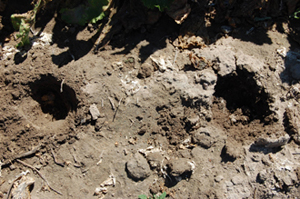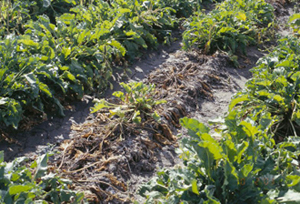G1841
Rhizoctonia Root and Crown Rot of Sugar Beet
Rhizoctonia Root and Crown Rot is the most consistently damaging sugar beet disease in Nebraska. Understanding symptoms, the disease cycle and management options can help control the disease.
Robert M. Harveson, Extension Plant Pathologist
Introduction
Rhizoctonia root and crown rot (RRCR), caused by the soilborne pathogen Rhizoctonia solani, is a common, endemic soilborne disease of sugar beet wherever the crop is grown. The disease threatens or affects economic returns on an estimated 24 percent of acres planted to sugar beet in the United States and from 5 percent to 10 percent in Europe. Losses caused by RRCR vary from field to field and range from negligible to over 50 percent.
It is also the most widespread, consistently damaging sugar beet disease in Nebraska. Part of the reason for this is that R. solani causes both seedling disease and two different phases of root rot later in season. In addition, the pathogen can survive for long periods in soils, and as disease becomes apparent, it is often too late to apply control measures.
Symptoms
Rhizoctonia root rot is characterized by sudden, permanent wilting (Figure 1). Leaves collapse on the soil surface and die but remain attached to the crown as a dry, brittle, dark rosette (Figure 2). Root symptoms begin as circular to oval, localized dark lesions (Figure 3) that coalesce to form larger rotted areas of the root as disease progresses, forming a ladder-like pattern (Figure 4). When roots are cut open there is a clear line of demarcation between diseased and healthy tissue, and rotted tissue usually is restricted to external layers of the root (Figure 5) and does not penetrate into the interior until advanced stages of disease. Diseased crowns and roots sometimes develop deep cracks or fissures, which deform roots (Figure 6). Two different phases of root rot have been reported, one being early infections occurring on taproots as a tip rot (root rot) (Figure 7), and progressing upward toward the crown of the root (Figure 8). The other phase involves infections beginning in the crown (crown rot) (Figure 9), often associated with soil thrown up into crowns during early cultivation (Figure 10). Both phases involve the same type of foliar symptoms. At harvest, severely infected roots may be completely decomposed, leaving holes in the ground within rows (Figure 11).
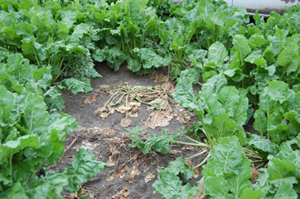 |
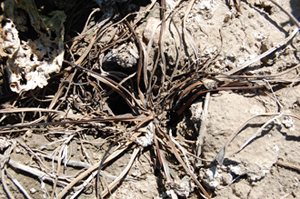 |
|||
| Figure 1. Foliar symptoms of Rhizoctonia root rot include sudden permanent wilting. | Figure 2. Plant killed by R. solani exhibiting dry rosette of dead leaves and petioles. | |||
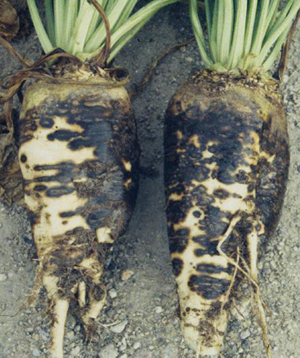 |
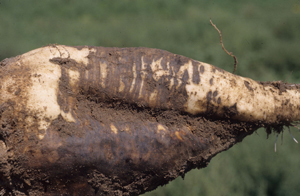 |
|||
| Figure 3. Initial infection consisting of discrete, circular-oval lesions. | Figure 4. Advanced infection showing larger rotted areas of root with ladder-like pattern. | |||
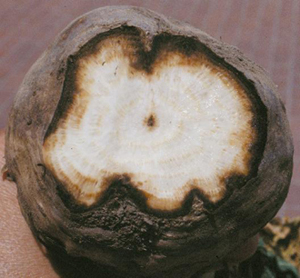 |
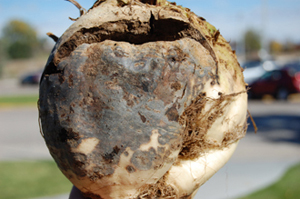 |
|||
| Figure 5. Extent of rotted area restricted to external layers. | Figure 6. Advanced infections showing cracks in taproot. | |||
 |
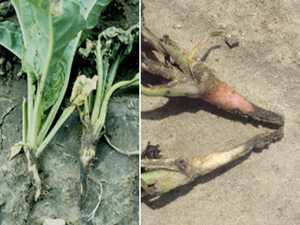 |
|||
| Figure 7. Early infection beginning on young tap root. | Figure 8. Root rot phase progressing from tip of root toward crown. | |||
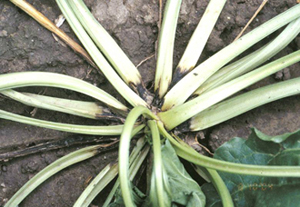 |
 |
|||
| Figure 9. Crown rot phase of infection. | Figure 10. Crown rot infection (note soil deposited in crown). | |||
|
||||
|
Pathogen and Disease Cycle
R. solani survives as thickened hyphae, sclerotia, and bulbils in crop residues and soil. Even if the pathogen is known to be present in fields, disease severity and incidence are still dependent upon soil populations and environmental conditions. The conditions required for disease development are not as specific as those required for rhizomania, or Aphanomyces root rot. Therefore, RRCR is problematic under a much wider range of environmental conditions.
The overwintering propagules germinate (hyphae also grow through soil) and infect sugar beet crowns, petioles and roots. Infection is favored by a temperature range of 55° to 95°F (12° to 35°C) and is optimal at 78° to 90°F (25° to 33°C) when soil is wet. Rhizoctonia root and crown rot has a broad host range that includes many species of weeds and other crops that may be grown in rotation with sugar beets. The disease occurs in all soil types but is often more severe in heavy, poorly drained, wet areas. Disease can spread down rows, affecting large numbers of plants (Figure 12). When humidity in the canopy is high, R. solani can also infect leaves, causing a foliar blight.
Management
- Cultivars with excellent levels of disease tolerance are available and should be used.
- Treating seed with fungicides will help prevent seed rot and damping-off.
- Adopt agronomic practices that encourage vigorous crop growth such as early planting, fertilization, soil drainage, and tillage.
- Use a minimum three-year rotation between sugar beet and nonhost crops, such as small grains, to prevent build-up of inoculum. Some rotation crops (e.g., soybean, edible beans, maize) are also susceptible to R. solani.
- Weed management will be beneficial because the pathogen infects numerous common species including pigweed, lamb’s-quarters, and fireweed (Kochia).
- Avoid throwing soil into crowns or “hilling” soil around plants during cultivation to decrease infections in the crown.
- Apply azoxystrobin to crowns shortly before infections occur.
Visit the University of Nebraska–Lincoln Extension Publications Web site for more publications.
Index: Plant Diseases
Sugar Beet
Issued April 2008
